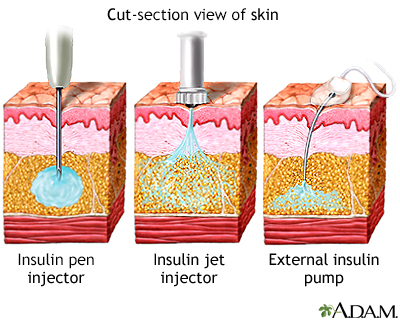| Step 6: Use insulin every day |
- Insulin
- Meal plan
- Blood glucose monitoring
- Exercise
Most people with type 1 diabetes need at least two insulin shots a day for good blood sugar control. Many diabetics take three or four shots a day. Insulin cannot be taken as a pill because it is a protein and would be digested before reaching the bloodstream. However, injections are not the only option -- a growing number of people get their insulin through an insulin pump, which is worn like a pager and described at the end of this step.
For those using injections, here's what you need to know:
- When to give the injections
- How to prepare the injections
- How to inject the insulin
- How to store the insulin
 |
|
People respond differently to insulin, and different types of insulin work at different speeds. Your doctor will determine the best insulin for your situation.
Insulin is divided into five categories, depending on how fast it works:
| Insulin Type | Begins working in... | Duration |
| Quick acting | 15 minutes | 3 - 5 hours |
| Short acting | 30 - 60 minutes | 5 - 8 hours |
| Intermediate acting | 1 - 3 hours | 10 - 18 hours |
| Long acting | 1 - 2 hours | 18 - 24 hours |
| Combination mixture | 30 minutes | 12 - 18 hours |
Injecting insulin: where and when
Insulin is injected into fat just under the skin using a small needle. There are several places in the body where it can be injected. Insulin works most consistently when injected in the lower abdomen. The body may absorb it faster if it is injected in the arm or leg, especially with exercise. Your doctor will discuss these methods with you.

Rotate the injection sites to give the skin time to recover at each spot. Always inject into fatty tissue, never muscle.
Depending on the type of insulin, injections need to be done 15 - 30 minutes before mealtime as directed by the doctor.
Other injection methods
Several other devices are available for people who prefer not to use a regular needle and syringe:
- Insulin pen injectors -- The insulin pen looks like an ink pen with a cartridge. On one end is a small needle, on the other is a plunger that you press to deliver the insulin under the skin. A dial on the cartridge allows you to select your desired dosage of insulin. Although it can cost more than a regular needle and syringe, the pen injector is a convenient and accurate device for using insulin. It can be a good choice for people who do not feel comfortable using a needle and syringe in public or at school or work.
- Insulin jet injectors -- This device releases a fine spray of insulin at such a fast speed that the insulin passes directly through the skin. Jet injectors are great for people who don't like to use needles, but they can be costly and may cause bruising, especially in thin people.
Insulin pumps
The insulin pump is a small device about the size of a pager that contains a supply of insulin. One type of pump can be worn in a pocket or on a belt. Thin plastic tubing leads from the device and ends with a needle that inserts just under the skin, usually around the abdomen. The pump delivers a small, steady amount of insulin all the time -- this is called the "basal" dose. In addition, you give an extra dose (a "bolus") before meals. You can give yoruself a "correction" does to even out the glucose level if it is too high or too low. A pump has programming and data tracking capabilities.
Pumps can help some people avoid glucose swings, control glucose during the hours you sleep, and overall provide tighter control of glucose levels. They allow a more flexible meal and activity schedule.
The pump is a very convenient method of insulin delivery, but like anything else there are drawbacks. The tube can become clogged or the needle can slip out, the insertion point can become infected, and there's a higher risk of ketoacidosis (described in step 10). It also requires frequent monitoring of blood glucose.
Despite these drawbacks, the number of people using insulin pumps is growing steadily. Some people love them; others try a pump and then go back to injections. There is usually a period of adjustment to using it and having it on the body all the time.

| As seen in an enlarged view of the skin, insulin is delivered into the fatty layer of the skin to help control the levels of glucose in the blood. |
References
American Diabetes Association. Standards of medical care in diabetes--2009. Diabetes Care. 2009 Jan;32 Suppl 1:S13-61.
Reviewed By: Nancy J. Rennert, MD, FACE, FACP, Chief of Endocrinology & Diabetes, Norwalk Hospital, Associate Clinical Professor of Medicine, Yale School of Medicine, New Haven, CT. Review provided by VeriMed Healthcare Network. Also reviewed by David Zieve, MD, MHA, Medical Director, A.D.A.M., Inc.
